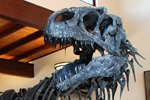

Cleveland-Lloyd Dinosaur Quarry |
|||||||||||||
Location: Emery County, Utah Time: ~148 million years ago, during the Jurassic period About this Famous Find: The quarry, located on public lands managed by the Bureau of Land Management (BLM), is located near the northern end of Utah's San Rafael Swell—a roughly oval, uplifted and eroded anticline—in the Brushy Basin Member of the Morrison Formation. There are a number of Morrison-age quarries that contain the bones of just one or two species of herbivorous dinosaur, but Cleveland-Lloyd is unusual in that it contains many bones of a large carnivore, Allosaurus fragilis. The bones of more than 65 individual dinosaurs have been collected at the quarry and 46 of those dinosaurs are Allosaurus. Four other species of theropod (six individuals), two sauropods (four individuals), and two ornithischians (nine individuals total) are also represented within the quarry. More than 12,000 bones have been excavated but it would seem that many thousand more remain to be uncovered. Skeletons excavated at Cleveland-Lloyd are exhibited in more than 65 museums around the world. The unusual nature of this site, i.e., the concentration of Allosaurus bones, has resulted in more taphonomic studies of this site than any other Morrison dinosaur quarry. Despite all the attention, the origins of this bone concentration are still debated. The bones are found generally disarticulated and intermixed within a one-meter-thick structureless mudstone; most researchers agree that the mudstone was laid down in a low-energy lacustrine environment. A 2005 study suggests that a population of Allosaurus met with a catastrophic death and then the carcasses lay exposed long enough for connective tissues to be removed. The somewhat weathered and disarticulated skeletal elements were transported to a depression by a sheetflood where further element mixing took place. The first studies of the Cleveland-Lloyd Quarry began in 1929. The quarry was designated a National Natural Landmark in 1966 and two years later the BLM opened its first-ever visitor center on the site. The BLM manages the visitor center and another building that encloses the quarry where research and excavations continue. Resources
|
|
site tour |
about the site |
site map |
site credits |
page credits |
help |
FAQs |
contact |
||

